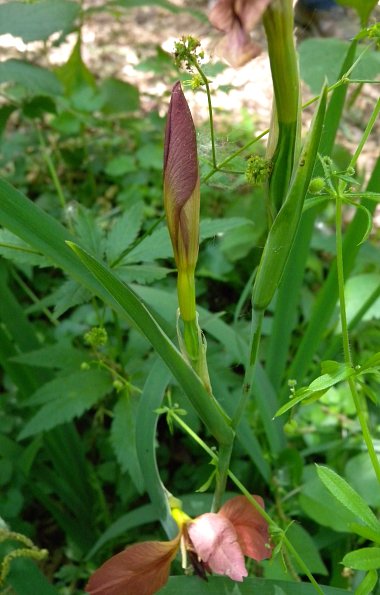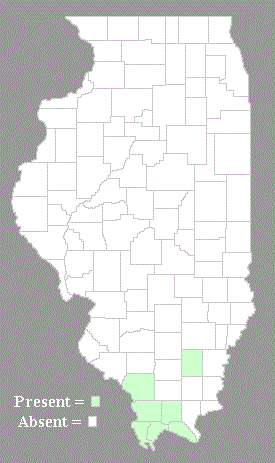
Each flower is 2¾–3½" across, consisting of 3 coppery sepals, 3 coppery petals, 3 coppery style branches, 3 stamens, and a 3-celled ovary. The petaloid sepals are slightly larger than the petals; they are both widely spreading and somewhat recurved. The sepals are obovate, while the petals are oblanceolate; they both have spreading dark red veins. The petaloid style branches are slightly ascending and oblong in shape; they are located above the sepals and their upper surfaces are convex. The stigmata and anthers are located along the lower surfaces of the style branches. The base of each flower is tubular and often yellowish. The blooming period occurs from late spring to early summer, lasting about 3 weeks. The flowers are slightly fragrant; individual flowers are short-lived (lasting about 1-4 days). Afterwards, the flowers are replaced by seed capsules that become 2-3" long and ¾-1" across at maturity; they are broadly ellipsoid in shape and 6-sided. The flattened corky seeds are arranged in 2 rows within each cell of a capsule. These seeds can float on water, by which means they can spread to new locations. The root system consists of stout rhizomes with coarse fibrous roots
 underneath. Clonal offsets
are often produced from the
rhizomes.
underneath. Clonal offsets
are often produced from the
rhizomes.Cultivation: The preference is full sun to light shade, wet conditions (including standing shallow water less than 6" deep), and poorly drained clay-muck with some decaying organic material. This wildflower can adapt to soil that is consistently moist, and it can be successfully cultivated in areas that are north of its native range (to Zone 4 or 5).
Range & Habitat: The native Copper Iris occurs in southern Illinois, where it is rare and state-listed as 'threatened.' Illinois lies along the northern-range limit of this species. It is found primarily in the lower- to mid-Mississippi valley of the United States. Habitats include swamps (including Bald Cypress swamps), soggy areas of bottomland and floodplain woodlands, low areas along ponds and sloughs, ditches along roads and railroads, and banks of drainage canals. Because of its attractive foliage and flowers, the Copper Iris is cultivated throughout the state. Native populations of this species have declined as a result of habitat destruction.
Faunal Associations: The flowers are cross-pollinated by the Ruby-Throated Hummingbird and bumblebees. The floral reward of these visitors is nectar; some bumblebees may also collect pollen. Insects that feed on the rhizomes of Iris spp. include the larvae of Eumerus strigatus (Onion Bulb Fly) and Eumerus tuberculatus (Lesser Bulb Fly), Dysaphis tulipae (Tulip Bulb Aphid), Rhizoecus falcifer (Ground Mealybug), and the larvae of Macronoctua onusta (Iris Borer Moth). Larvae of the moths, Ctenucha virginica (Virginia Ctenucha) and Spilosoma congrua (Agreeable Tiger Moth), feed on the foliage, while larvae of a polyphagous moth, Endothenia hebesana (Dull-Barred Endothenia), bore into the seed capsules. Other insect feeders of Iris spp. include larvae of a picture-winged fly (Chaetopsis aenea) that feed on the flower buds, and a thrips that feeds on the flowers, Frankliniella occidentalis (Western Flower Thrips). Because both the foliage and rhizomes are toxic, mammalian herbivores usually leave Iris spp. alone, although the Muskrat occasionally feeds on their rhizomes and lower stems. The webmaster also observed some cropped leaves while photographing the Copper Iris, suggesting possible grazing by White-Tailed Deer.

Photographic Location: A floodplain woodland in Springfield, Illinois, where this species was introduced.
Comments: This beautiful iris is worthy of cultivation in gardens. Because of the unique coloration of its flowers, the Copper Iris is very easy to identify when it is in bloom. Like other native Iris spp. in Illinois, the flowers of the Copper Iris lack tufts of hair on its petaloid sepals. It can form a naturally occurring hybrid with another native iris, Iris breviscaulis (Zigzag Iris); this hybrid has been named Iris × fulvala. It has reddish purple sepals.